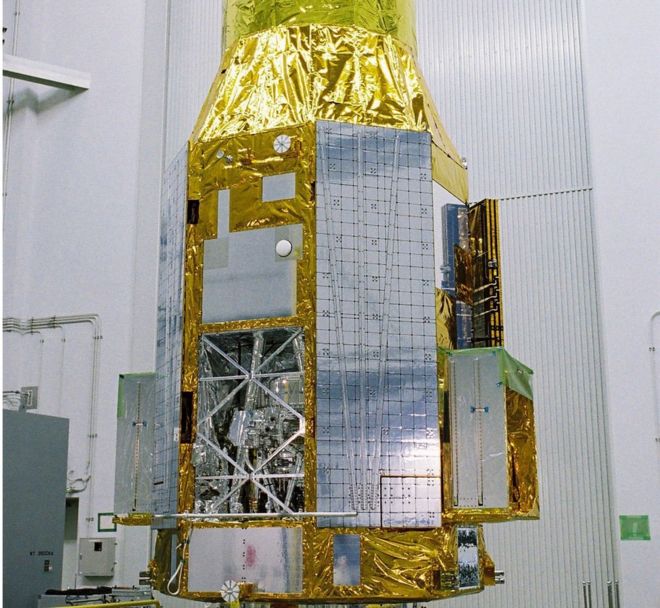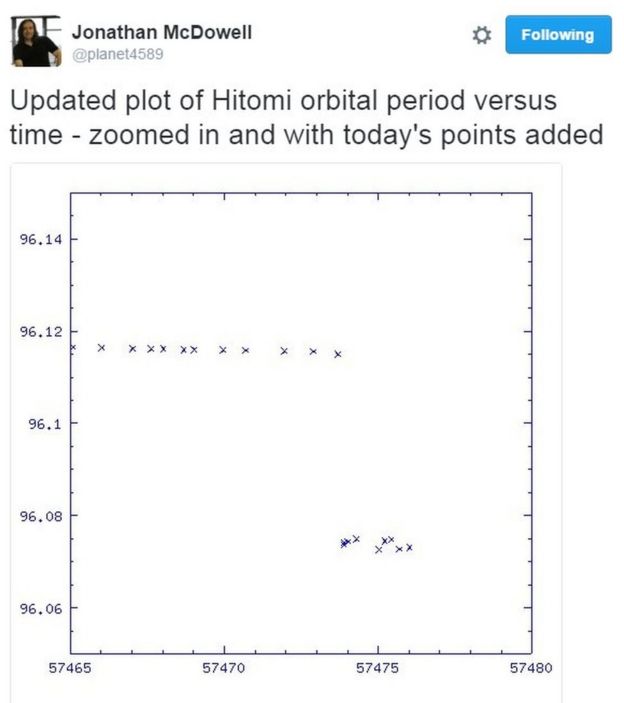
Hitomi, meaning the pupil of the eye, was launched last month.
It was designed to study energetic space objects such as supermassive black holes, neutron stars, and galaxy clusters, by observing energy wavelengths from X-rays to gamma-rays.
But time is now running out to save the mission.
What happened?
On Saturday, the US Joint Space Operations Center (JSpOC), which tracks space debris, detected five small objects around the satellite.
Ground control in Japan managed brief contact with the spacecraft after that, but then lost contact.
The satellite also appeared to show a sudden change of course, and observers on Earth have seen it appearing to flash, suggesting it may be tumbling.
The next day, JSpOC referred to the event as a "breakup", although experts have clarified that Hitomi may well be mostly intact.

What has happened to it?
The Japanese space agency (Jaxa) told the BBC it did not know right now, and that the agency was still trying to restore communications with Hitomi.
Jonathan McDowell, an astronomer at the Harvard-Smithsonian Center for Astrophysics, told Associated Press that two possibilities were that the spacecraft might have suffered a battery explosion or a gas leak, putting it into a spin and out of contact.
"To hear that they've run into this piece of bad luck, it's so very sad. I know enough about how the sausage was made to know that this could have easily have happened to us. Space is very unforgiving."
But Prof Goh Cher Hiang, project director of the satellite programme at the National University of Singapore, told the BBC that thanks to monitoring and backup systems, battery explosions were "very rare", and while a leak in the pressurised fuel tanks found on satellites could cause the trouble, "the designer of it can give us some kind of clue".
External factors could also be a reason, he added.
"It could also be from a collision with something in space, either from outer space or a man-made object already in space."
Small objects are not necessarily detected by ground radar, he points out, and with even tiny pieces a "collision can cause serious damage" because they are travelling so fast.
line break
Satellites missing in action
Despite decades of practice, getting satellites into space in perfect working order is still tough.
A Russian defence satellite was lost last December after it failed to separate from the rocket carrying it to orbit
Nasa's Earth-observing satellite Glory did not make it into orbit in 2011, when the protective nose cone on its launcher failed to separate
In November last year, a US defence "nanosatellite" launched on a new type of rocket and learnt the hard way that being first is not always best, when it broke up after lift-off
In 2000, the rocket carrying Japan's Astro-E satellite crashed into the sea
Suzaku, Astro-E's successor, made it into space, but its main instrument was disabled by a helium leak in 2005
Proving that you should never give up though, Jaxa recently got its Akatsuki spacecraft into Venus orbit a whole five years after it was thought lost because of a failed engine burn
Alexis, a US X-ray satellite, went dark after launch in 1993, before engineers managed to re-establish contact, months later
Source: BBC
Nenhum comentário:
Postar um comentário